The Ultimate New Zealand Soccer Website | home
1996 Tri-Series and PNG | 1997 Tri-Series Review | 1998 Oceania WWC Qualifying Review | 2000 Pacific Cup Review | 2001 ICL Tournament | 2003 Oceania WWC Campaign | 2004 Australia Cup | 2004-5 - USA and Japan | The Elite Squad
The Elite Squad
A New Direction For New Zealand Women's Soccer
by Jeremy Ruane (April - May, 2005)
Women's soccer in New Zealand has embarked upon a highly significant change of direction in 2005, at the behest of NZ Soccer.
While the same competitions at club and provincial level will continue in much the same manner as before, they will do so this time without the involvement of the country's elite players - current internationals and
potential wearers of the silver fern alike.
For the likes of Maia Jackman, Melissa Ray, Zoe Thompson, Kirsty Yallop, Zarnia Cogle and company, the days of playing for Three Kings United, Lynn-Avon United, New Brighton, Auckland and Canterbury are no more.
Instead, they, and others of like ilk, have committed themselves to being part of the Elite Senior Women's International Development Group, a collection of players from around the country who were invited to be part of this initiative by NZS, as the national body puts in place a long-term strategy “for players to achieve footballing excellence to perform against the best international players and teams in the world” (to quote the blurb).
Modelled on practices in Scandinavia - all five women's soccer-playing nations from that area of the world consistently appear among the top twenty in FIFA's quarterly women's rankings - the New Zealand plan has been devised and implemented by National Goalkeeping Coach, Mick Leonard.
Why?
“Having seen for myself over the course of 2004 the various women's soccer leagues and competitions throughout the country, the standard is such that, for our top-class players, these games serve little purpose - they aren't consistently competitive enough, and fail to provide these players with the sort of challenges they require to be able to compete at the level required of them on the international stage.
“If we are realistic about our goal of qualifying for the 2007 Women's World Cup Finals in China, we need to change what we are presently doing in order to give ourselves the chance to be competitive and achieve our objectives on the world stage. To do this, the top players need more intensive training, improved levels of fitness and competitiveness, and better technical ability”.
Consequently, NZS has made a significant investment in the women's game in order to provide an environment in which the players can achieve that, with some of our best-qualified coaches holding highly concentrated training sessions in Auckland, Wellington and Christchurch every Monday, Tuesday and Thursday evening from mid-February through to mid-December.
As well, the players will gather in Auckland twice a month as a group, once for training and also to take part in matches against male teams of a suitable standard. Atop this, each player will have a personal programme to follow, incorporating technical coaching, and medical and physiological support.
It's certainly a major commitment for the players in particular to make, challenging as it does long-established “comfort zones” and traditions such as playing for your club every Sunday, and training twice a week … indeed, to some extent it directly challenges the idea of the club as the cornerstone of the game in this country.
This initiative presents a lot of questions, as you would expect, and Leonard was more than happy to oblige ...
Why isn't the same approach being mooted for male players?
“The scheme that's being piloted for the senior women's group has come about due to the Technical Department and the Board of New Zealand Soccer
both being of the view that gaining success with this group of players at international level is a definite possibility.
“The majority of these players are preparing for the 2006 Under-20 Women's World Cup Finals in Russia, and the 2007 Women's World Cup Finals and the 2008 Olympic Women's Football Tournament, both of which are taking place in China.
“If it proves successful, and there's no reason why it shouldn't be, I can see no reason why this scheme can't be extended to embrace our younger male players, as they prepare for future Under-17 and Under-20 World Cup campaigns”.
What happens to those players left behind - from whom do they learn at first-hand given they won't be playing with or against elite players?
“The players not selected for inclusion in this Squad haven't been left behind. They can be introduced into the Squad from their local teams, clubs, schools and federations, the developmental role of all of which
remains unchanged.
“The CoachForce scouting system, under the direction of Kevin O'Leary, will be looking at the players on show in their respective areas, and those identified as being of international standard, or showing the potential for same, will be drafted into the Squad.
“Why they haven't been selected at this stage is due to their having not yet been identified as showing the promise required at their current level. When they do so, the opportunity is in place for them to progress.
“By the same token, any player in the Squad who doesn't maintain the levels required for international football will be released back to their club, where they can endeavour to improve their game and look to force their way back into the Elite Squad.
“When the whole initiative kicks in, we'll hopefully have what amounts to a virtual conveyor belt of talented young footballers striving to be part of the Elite Squad, and the opportunities that opens up for them”.
What does this mean for the National Women's League, and, indeed, for the general standard of women's soccer?
“So far this season, I've watched two women's matches, and the initiative we've introduced has made the women's game far more competitive - it hasn't
harmed it at all.
“All players involved will get more out of fixture such as Lynn-Avon United's 5-3 win at Waitakere City than they would had the same match taken place with Lynn-Avon having their Elite Squad players in harness.
“The latter would have been a one-sided contest, with the scoreline approaching double figures - a regular occurrence in most matches for teams boasting Elite Squad members in recent years, as history shows. That
situation is beneficial for nobody - neither the international players, nor those on the receiving end, whose playing aspirations are more fun and socially oriented.
“The same situation applies with the National Women's League, which will result in a more even competition for players at that level”.
How are the performances of both players and coaches going to be measured?
“Players' fitness levels are constantly monitored and maintained by the Exercise Sports Science team. Their playing performances are addressed through the Elite Squad process, as outlined a couple of questions ago.
“Coaches, of course, are ultimately judged on results, but in terms of this initiative - giving it time to become established, etc., those judgements should be made in the long-term, not the short-term.
“Women's soccer in this country has never had anything at this level of intensity. They have experienced people working with them, and I'm confident enough with the young players we have that success is distinctly possible.
“We will make progress - indeed, we've made really significant progress in the last year. We need to have success, however, to show young women there's a good future for the women's game - it's not just netball where they can succeed.
“The sport of women's soccer is growing massively,
|
From the training ground ...
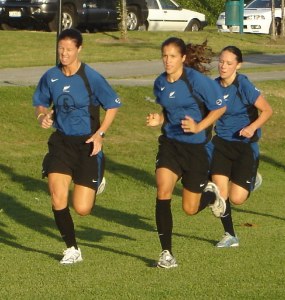 The phenomenally fit trio of Maia Jackman,
Zoe Thompson and Hayley Moorwood plough
through the pain barrier on the lung-busting
endurance test that is the Pyramid Run
 Lights, camera, action ... a panoramic of some of the squad working on a passing drill
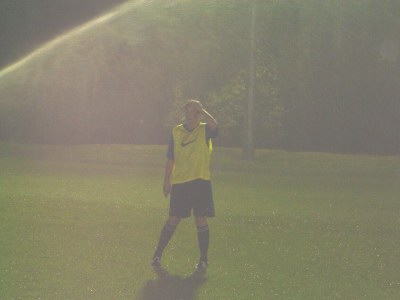 The night the sprinklers popped up early ... and poor Melissa Ray just happened to be in the wrong place at the wrong time when they did!
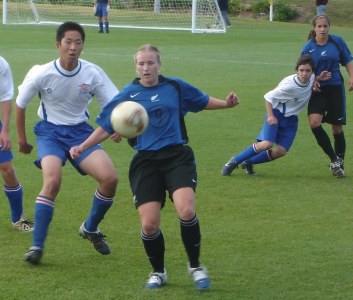 Michele Keinzley in action against Rangitoto College ... as the lad in the background makes an unusual move
on Zoe Thompson!! (Don't ask!!!)
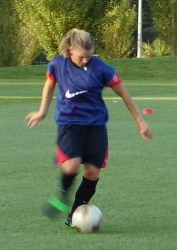 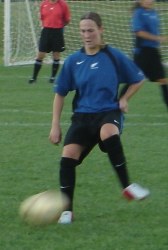 Petria Rennie and Kirsty Yallop
Some of the stars who come out at night ... to train under North Harbour's matchsticks!!
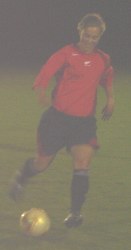 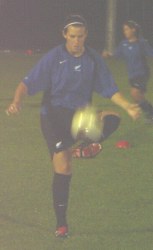 Hannah Rishworth and Hannah Bromley
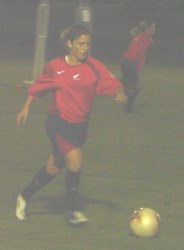 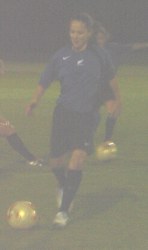 Pip Meo and Hayley Moorwood
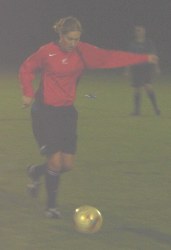 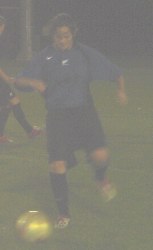 Melissa Ray and Sarah Gibbs
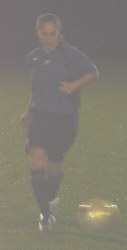 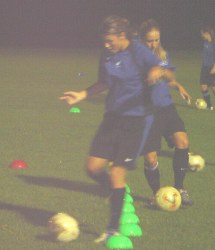 Rebecca Sowden, Leah Tagaloa and Rebecca Simpson
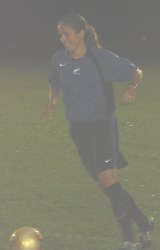 Zoe Thompson
|
and we need to capitalise on it. If this initiative is paying dividends - and I'm convinced it will be a success, `cause we've a number of young players with
all the attributes to compete at the very top level of the international game within five years - then it's up to the investment of the organisation to make the most of the situation.
“Already, there is a solid foundation in place with the International Player Development Programme, and both the Regional Academy and National Centres structures, all of which have been implemented by the NZS Director of Football, Paul Smalley.
“Together, these will, in time, produce international quality players on a regular basis. Make no mistake, we are striving for continued success on the international stage and a solid foundation for years to come, and not a “one-hit wonder” success as was achieved by the All Whites in 1982”.
What benefits do those training in Wellington and Christchurch get, given each group is so few in number? And, given the players only get together as
a group once a month for training and once for a game, how is competition going to be managed?
“Because of the lack of numbers of players in the Elite Squad from those areas, and due to budgetary constraints, we have made a couple of key decisions in recent weeks.
“One is to allow the Wellington- and Christchurch-based players to return to their clubs. It's better for them to get game-time at club level, while we improve the numbers of players within those centres who satisfy the criteria outlined earlier.
“Regular contact is maintained with Andy Hedge in Wellington, and John Whittle in the South Island, who monitor the progress of the Elite Squad players in their area, and monitor the situation with clubs as well.
“The other decision we have made, after having seen all the Elite Squad players in action in our first couple of fixtures against age-grade boys' teams, is that all players nationwide will play in future games of this
nature by invitation. These will be extended on the basis of players' progress reports”.
What is the programme for New Zealand's women?
“Outside the senior players, there will be age-group activities for the Under-16s and Under-18s, as we build towards future Under-20 Women's World Cup competitions.
“At senior level, we will be playing two matches against age-grade boys' teams each month, and in May, we will be playing two internationals in Japan - the first, a full international against Japan's national women's team, and the second fixture against the Japanese Universities squad.
“Plans are afoot to play more international fixtures during the year - at least one more, certainly”.
Meanwhile, the locally-based players - overseas-based players will also be added to the squad - are taking to the task ahead of them with gusto, and are finding the training sessions fairly demanding, which is as it should be. Some of the elite were receiving this concentrated training on Monday evenings throughout last year, before reverting to club training sessions,
which they found nowhere near as challenging.
Now they are getting the same level of intensity in training three times a week, and, quite frankly, they're loving it! As well they should, for while they are Elite Group members at present, they will only remain so as long as they are making progress towards the required standard.
If not, they will be released back to their clubs, where their progress can be monitored by Coach Force national development officers. At the same time, said officers will be looking to identify players with international potential, who, if considered good enough, will be extended an invitation to join the Elite Group.
A lot of what the squad has done thus far has concentrated on raising their fitness levels, and by Godfathers, they are certainly put through their paces, e.g. a lung-busting twelve-minute run around a 400m course has seen both Maia Jackman and Hayley Moorwood travel over 3000m in the allotted time, with Zoe Thompson and Sarah Gibbs not too far behind that pair.
There has been plenty of variation to the fitness work, too, with different obstacles and variations introduced along the way to keep the players mentally focused on what's required of them in each exercise. The players
aren't racing each other, however - they are racing themselves, pushing themselves to improve on their last attempt on the circuit in question, just as you look to improve on the last round of golf you played on a given course.
During a typical evening's fitness training, you can see when individuals are pushing themselves to what they think are their limits. However, one look across at Jenny Bindon - just six weeks on from giving birth to her first child - who is doing exactly the same exercise as they are, encourages them to push themselves still further.
Ball-work has been gradually introduced also, with emphasis in the initial stages largely on introducing elite group “newbies” to the style and patterns of play which New Zealand's National Women's Team, to give them their full title (despite its links to the past, give me the far more media-friendly SWANZ tag any day!), employs.
Elite Squad Fixtures
|